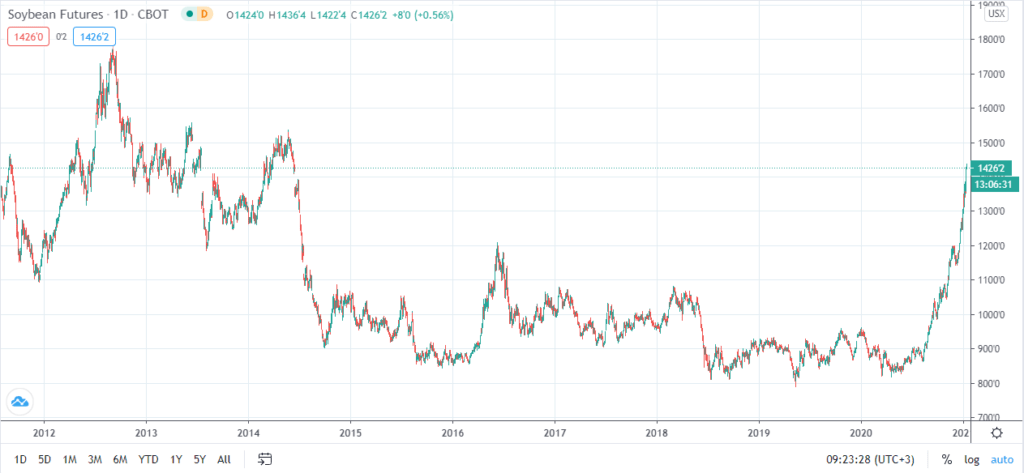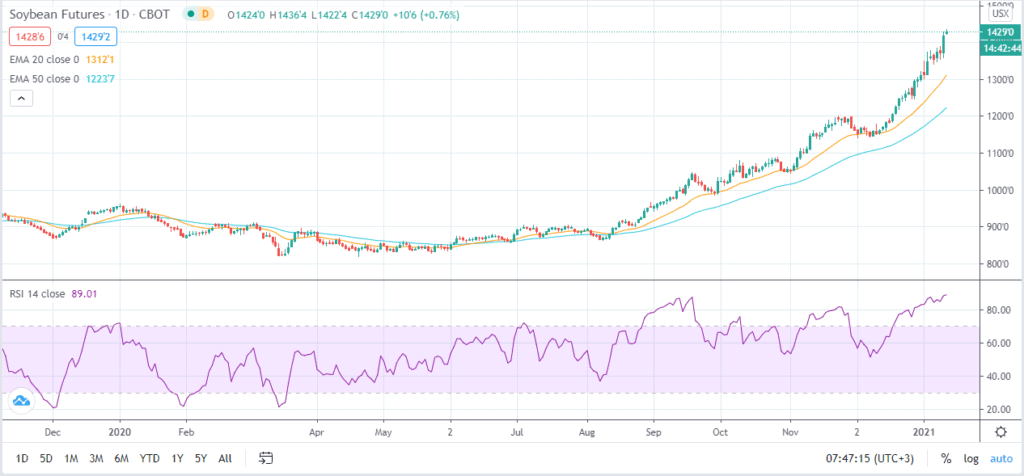
Soybean prices surge to a 7-year high after a bullish WASDE report
- soybean prices have risen past $1400 to trade at around $1424; the highest price since June 2014.
- USDA released a bullish WASDE report characterized by reduced production in the US and Argentina.
- The agency has left its estimates for Brazil's output unchanged at 133 million tonnes.
Soybean prices are at their highest level since June 2014. The commodity’s price has tested and surpassed the psychological level of $1400. On Wednesday, it was trading at around $1424, which is a surge of 0.41%. The upward momentum is largely a reaction to the bullish WASDE report released on Tuesday.

January’s WASDE report
Copy link to sectionOn Tuesday, the US Department of Agriculture released January’s WASDE report for the 2020/21 season. According to the agency, soybean production is set to decline by 35 million bushels to 4.135 billion bushels. This is despite estimates for the harvested area being at 82.3 million acres, which is slightly up from December’s report.
Furthermore, the crop yield is expected to be 50.2 bushels per acre; a figure that represents a reduction of 0.5 bushels. USDA has attributed the predicted reduction in production to the output decline in US soybean-growing areas like Kansas, Iowa, and Minnesota.
Evidently, the US soybean stocks are getting tighter. With reference to the scenario, Ben Brown, an economist from the University of Missouri has said, “If you look at soybean stocks as a percentage of our use, it’s at 3%, which is very tight…This is some of our tightest stocks we’ve seen in the last couple of decades, when you look at that percentage of use.”
This outlook has further been substantiated by the USDA’s numbers on imports and exports. The agency’s exports forecast is higher by 30 million bushels to 2.23 billion bushels; which is a record figure. At the same time, compared to the December report, estimates of soybean supplies have been lessened by 14 million bushels.
Besides, the output from Argentina is expected to decline due to the ongoing dry weather. Production in this South American nation has been predicted to decline by 2 million tonnes to reach 48 million tonnes. Notably, the department has not adjusted its estimates for Brazil’s output; leaving it at 133 million tonnes. As such, the market may have to deal with low supplies for about 3-4 weeks before the Brazilian produce begins to come in. Those whose interest is to invest in commodities forecast that the prices will continue in the current uptrend.
Soybean prices technical outlook
Copy link to sectionIn a daily chart, soybean futures are trading above the 20-day and 50-day exponential moving averages. From this perspective, the uptrend is set to remain in the mid-term. Besides, the prices have tested and managed to break out past the psychological level of $1400. This is its highest mark since June 2014. Based on the prevailing market forces, the bulls are in a position to control the market for a while.
However, I suspect that soybean prices will pull back before reversing to the upside. With an RSI of close to 90, the prices are way into the overbought zone. Investors will probably take profit before more buyers jump on and push soybean prices higher. For novice and experienced traders alike, trading courses are helpful in establishing an apt trading strategy.

More industry news







